The DU Lounge
Related: Culture Forums, Support ForumsMy Great War Aeroplane Collection
Last edited Sun Jul 18, 2021, 12:30 PM - Edit history (3)
These have been packed away for moving and, as they are quite fragile, I will be surprised if all make it intact. So I thought I would memorialize them here. They are a mix of scratch-builds, kits re-worked extensively, and kits more or less assembled straight. All are in 1/72 scale (six feet to the inch). Several of these represent machines whose individual histories some might find particularly interesting, and for those I am including links to full accounts posted up on a modeling site I frequent.
First the scratch-builds:

This is the prototype Morane-Saulnier Type N militaire, flown in the summer of 1915 by Sgt. Gilbert. He had been a racing pilot for the firm before the war, and when his former team-mate, Roland Garros, was brought down behind German lines in April, he prevailed on the company to give him this armed machine, which he dubbed The Avenger. It is the first scratch-build I completed. I have since seen a photograph from which the serial number was not censored, but at the time I took that absence at face value, since the machine was company property when Gilbert received it.
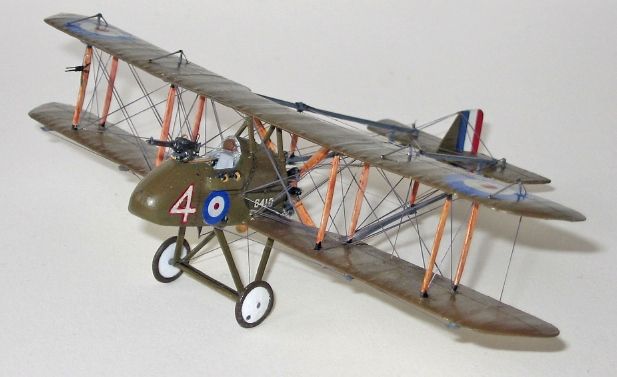
This is an F.E. 8 of No. 40 Sqdn, Royal Flying Corps, in August of 1916 at the Somme. Odd as this appears, at the time it was designed, machines of this configuration were quite effective fighting aeroplanes. Production of this one was delayed by a good half a year owing to inexperience of the contractors, so it arrived at the front barely weeks before far superior fighting machines came into German service.

This is a Caudron G.III of Escadrille C.11 at the Marne in September, 1914. This machine became the standard French type for artillery spotting during most of 1915, and then began long service a trainer. It was sturdy and easy to fly, by all accounts. I won prize money in a contest with this one.

This is the Morane-Saulnier Type L 'Parasol' flown by Georges Guynemer in July, 1915, in an air fight with a German Aviatik which his mechanic, Charles Guerder, shot down behind the French lines. Guynemer went on to become an extraordinarily successful fighting pilot, and a popular hero of legendary proportion in France. He did not return from a sortie in mid-September, 1917.
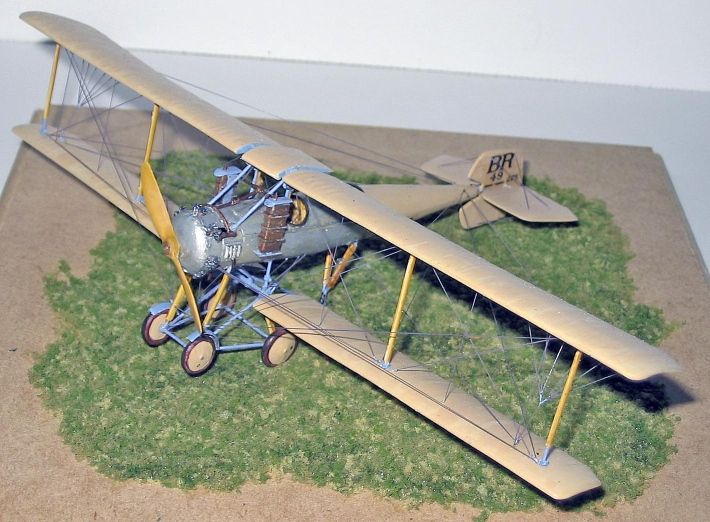

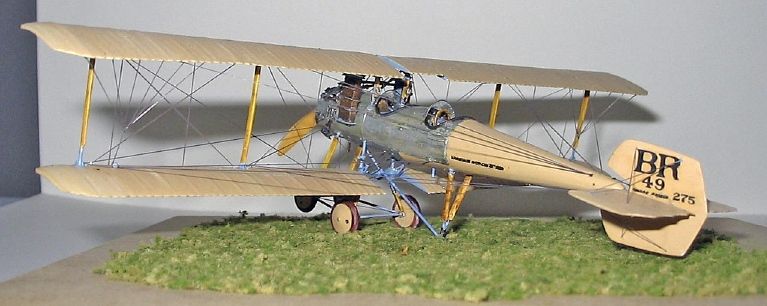
This is a Breguet U.1 'affine' of Escadrille BR17, on the Alsace front in September, 1914. It was flown by Sgt. France Vaurin, who was awarded the medal militaire for undertaking 'numerous hazardous flights' in the machine. It was a wretched thing to fly, and just about any time it went aloft ought to have counted as hazardous. It was quite difficult to make, and is the one which left me thinking I could manage just about anything....

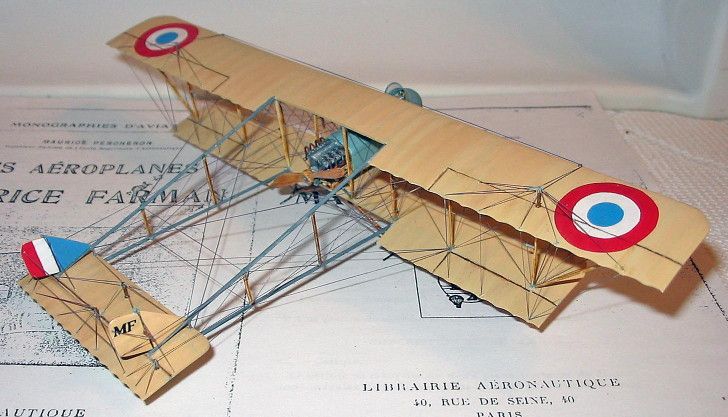

This is a Maurice Farman M.F. 11, of Escadrille MF62 at the battle of the Artois in September 1915. This type was in service when the war began, and became the standard French reconnaissance machine throughout 1915. This one is carrying MF62's 120cm focal length camera, used for getting a closer look at things deemed of particular interest from routine photos or reports.



This is a Martinsyde G.100 Elephant operating at Baku in September, 1918, as part of 'Dunsterforce' against Enver Pasha's Army of Islam. It is quite the ripping yarn, and more information can be found here by anyone interested:
https://www.britmodeller.com/forums/index.php?/topic/235096415-martinsyde-g100-elephant-with-dunsterforce-at-baku-september-1918/


This is a Caudron G.VI of Escadrille C575, at Port Said, Egypt, in autumn of 1918. Known as "l'Escadrille de Palestine", C575 retained the Caudrons after the war, based in Lebanon. A family resemblance with the G.III above may be detected, as this is in effect a twin-engine G.IV with a fuselage rather than bare longerons. The camouflage pattern is largely conjectural, but this machine was painted in the 5-colour scheme. Wife did the escadrille markings.


This is the Breguet A.G. 4 (the is used advisedly, there was only one at the time) donated to the camp retranché de Paris late in August, 1914. In early September, with its designer M. Breguet at the controls, and Lt. Watteau as observer, this machine was flown on a sortie whose significance was little short of that of Enola Gay over Hiroshima. They brought a report in the position of German armies approaching Paris which led to the Battle of the Marne, which resulted in the war being no mere summer campaign but years of grueling death and destruction.
https://www.britmodeller.com/forums/index.php?/topic/234929495-breguet-ag-4-september-1914-paris-scratch-build-in-172/
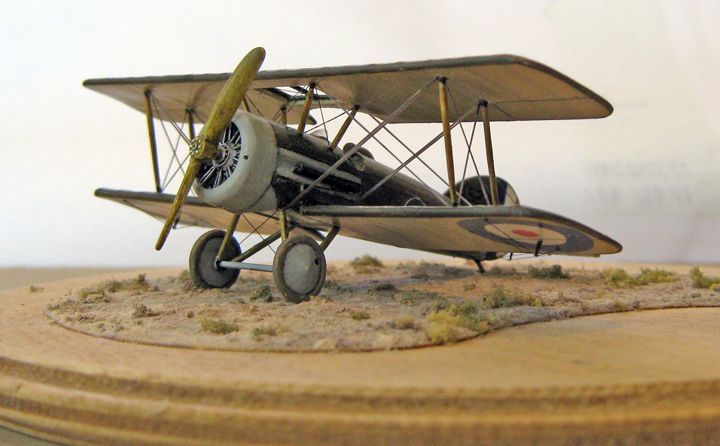
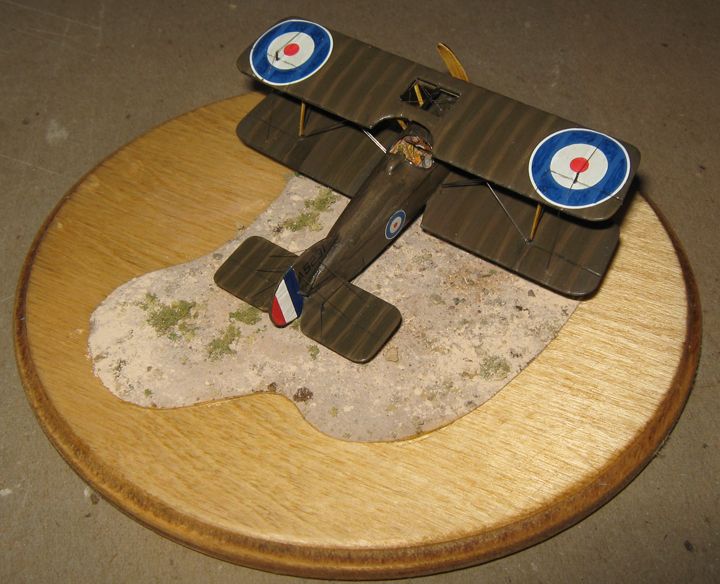
This is a Vickers 'Bullet' FB.19 mkII flown by 14 Squadron RFC at Gaza in Palestine during the summer of 1917. It is an odd case, for it was an excellent flying machine, but a very poor fighting aeroplane. An earlier version was ordered by Czarist Russia in quantity, and had one photograph been a bit clearer, I might have chosen for a subject one which survived into the Soviet air service, and was part of the liquidation of the Kronstadt Rising against Lenin's government.
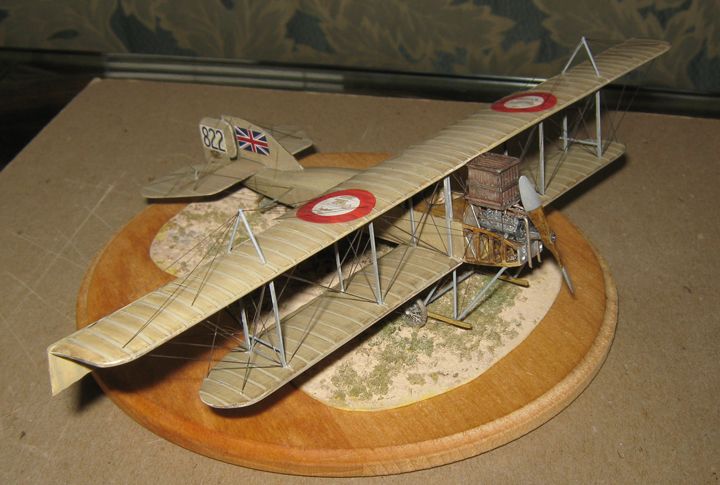

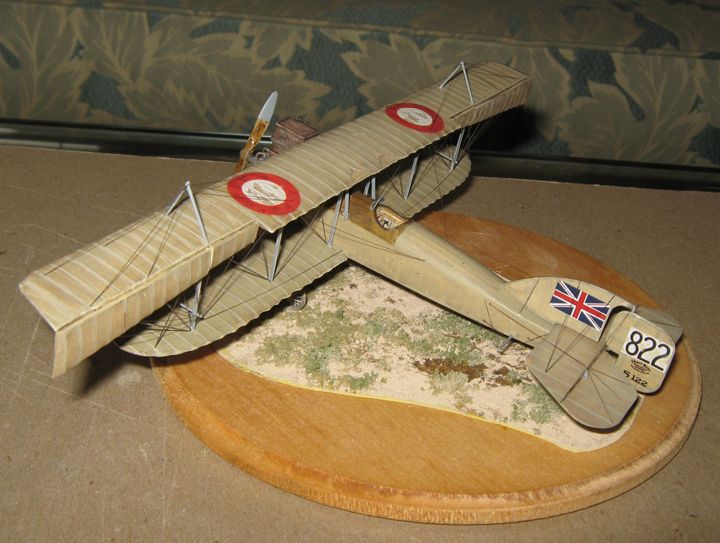
This is a Short 827, with floats removed and wheels fitted. It was flown frequently by Flight Sub-Lieutenant Dunn of the Royal Naval Air Service. It was part of a small detachment operated by the R.N.A.S. 'up the Tigris' in autumn of 1915, in support of Gen. Townsend's 'Force D' at Kut al' Amara. This campaign by the Indian Army in Mesopotamia became one of the great disasters of English arms. More can be found by any interested here:
https://www.britmodeller.com/forums/index.php?/topic/234964852-short-827-converted-rnas-mesopoptamia-1915-scratch-build-in-172/&tab=comments#comment-1694895
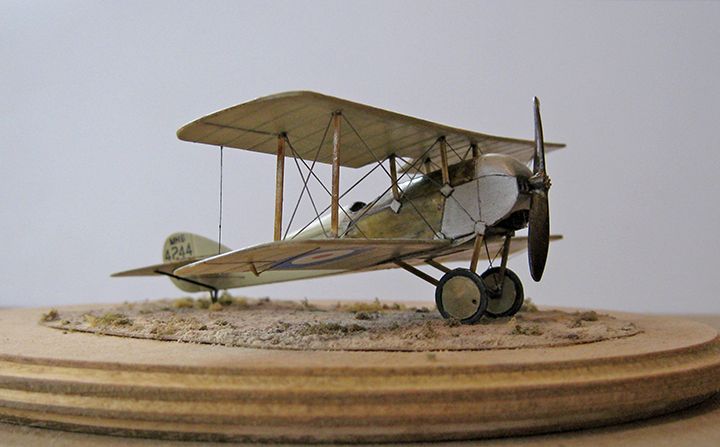
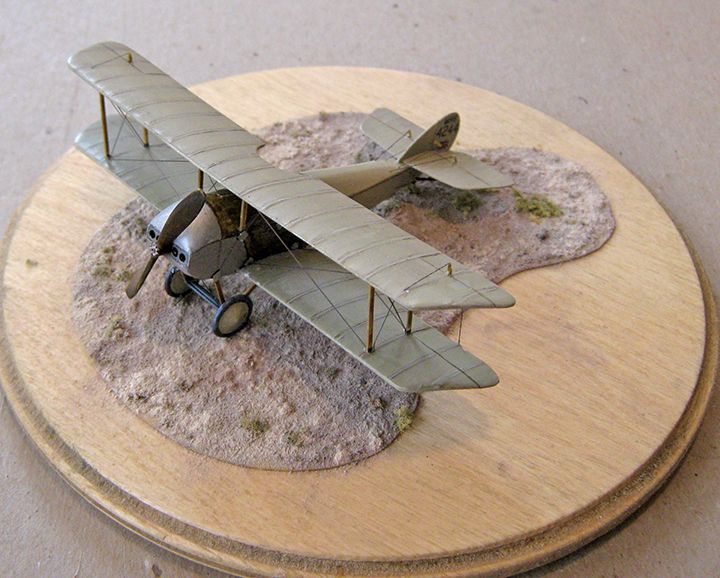
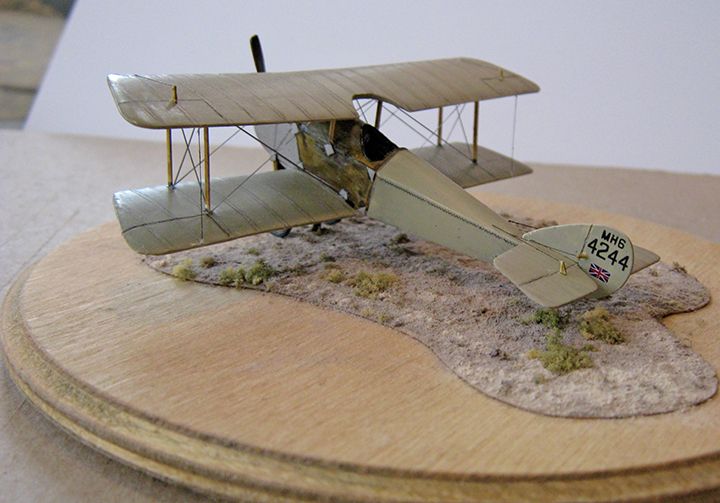
This is a Martinsyde S.1 'Scout' flown by Major H. L. Reilly of the 82nd Punjabis, in support of Gen. Townsend's 'Force D' advancing up the Tigris in the summer of 1915. It would not be stretching things much to say that a single Turkish bullet striking this aeroplane led directly to the ghastly siege of Kut al' Amara, and the surrender and captivity of the survivors of Gen. Townsend's 'Force D'. It is, again, something of a ripping yarn, and any interested may find more here:
https://www.britmodeller.com/forums/index.php?/topic/234970973-martinsyde-s1-scout-30-sqd-rfc-kut-al-amara-mesopotamia-autumn-1915/&tab=comments#comment-1796290

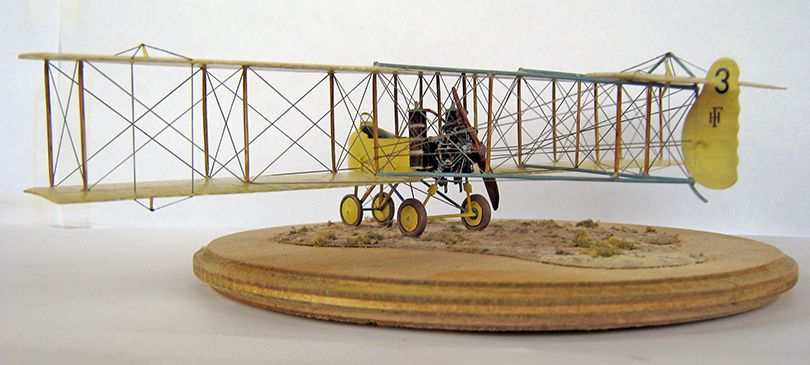
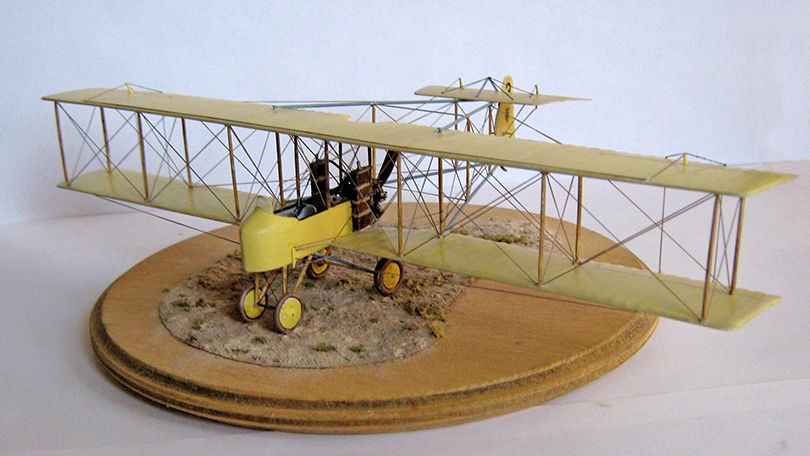
This an Henri Farman H.F. 27 'Steel Farman' operated during June, 1915 by the South African Air Corps in the German Southwest Africa campaign. This was an operation in extremely harsh conditions, which began in a welter of half-measures, defeat for, and rebellion within, the South African military forces. I knew little of the matter when I set out to build this model (in fact, I meant to do one operated in India on the Northwest Frontier in 1917), but it proved a fascinating tale. More can be found by any interested here:
https://www.britmodeller.com/forums/index.php?/topic/234992274-henri-farman-hf-27-south-african-air-corps-june-1915-scratch-built-in-172/
These are models from kits which have been re-worked a good deal, either to produce a different type, or to correct various errors in the kit itself.
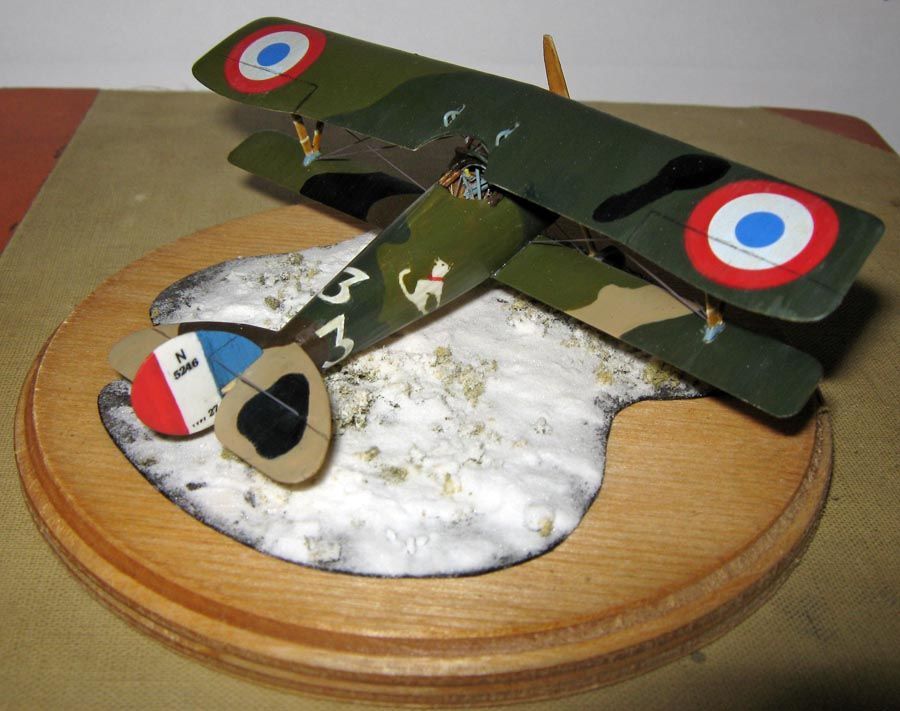
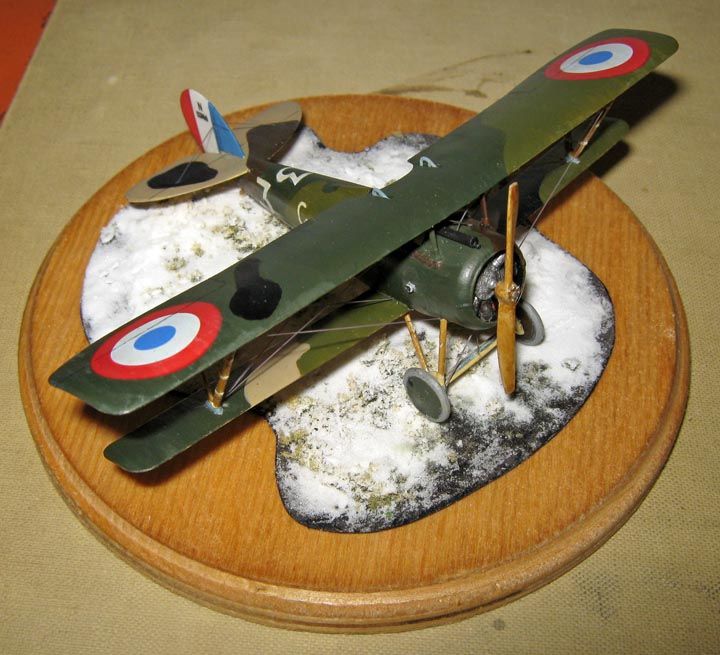
This is a Nieuport N.27 of Escadrille N87, flown by Lt. Descours, early in 1918. It was made from an Eduard N.17 kit, by 'fleshing out' the sides of the fuselage to the rounded section of later Nieuport sesquiplane types, along with small alterations to the upper wing. Unit marking is hand-done using reverse masking on white plastic (this is before home decal printing, too). M. Descours, I learned later, had quite a career as a pioneering flier in Indo-China after the war.
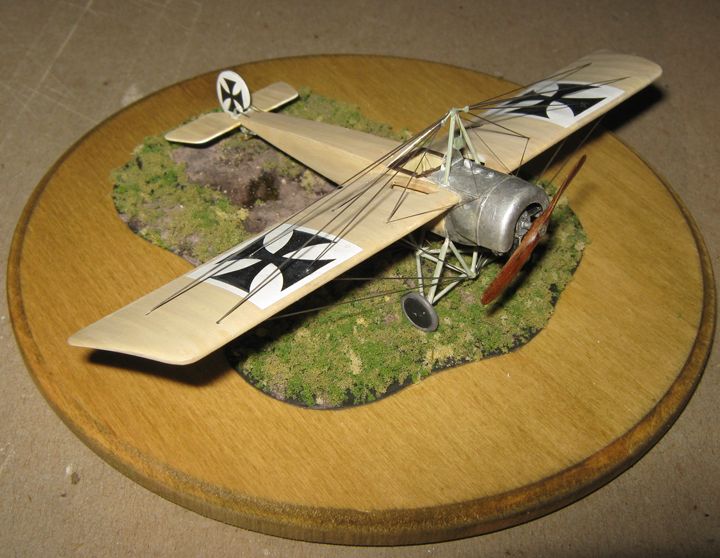
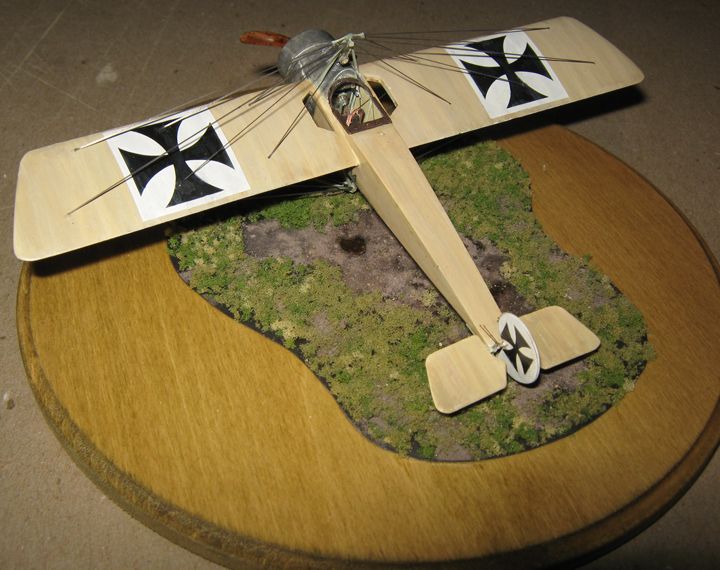
This is a Fokker AII (military version of the M.5 with long-span wings), in summer of 1915 on the Russian front, where they were employed mostly for liaison and scouting. It is a conversion employing two Eduard E.III kits.
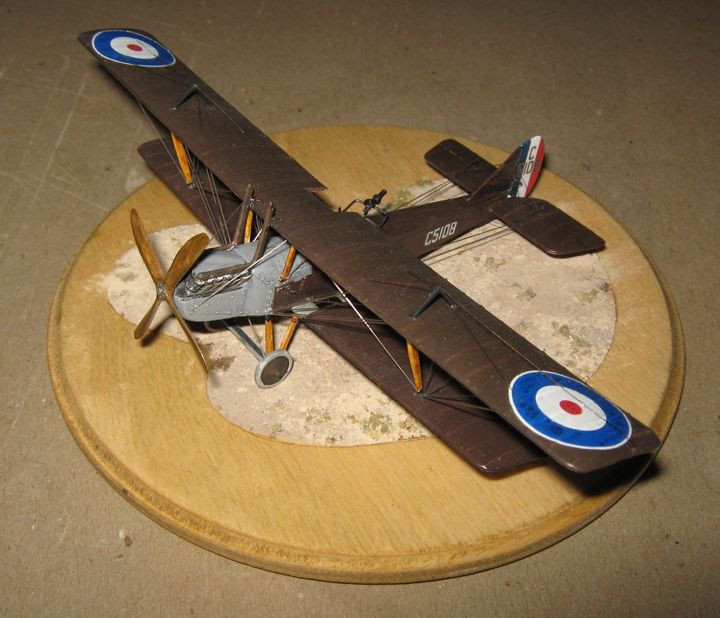
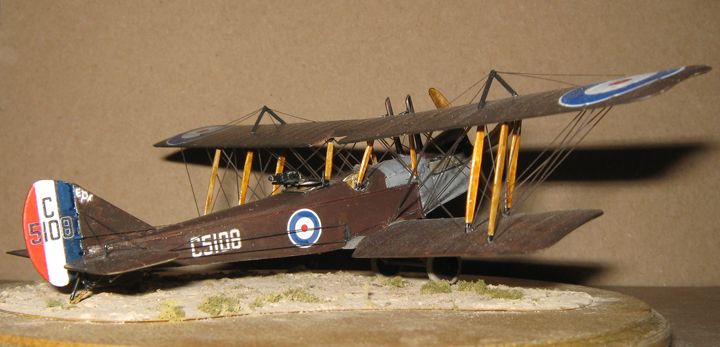
This is an R.E. 8 of No. 5 Fighting School at Abu Suier, a major RAF base in Egypt, in mid-1919. It is the result of major surgery on an Airfix R.E. 8 kit.
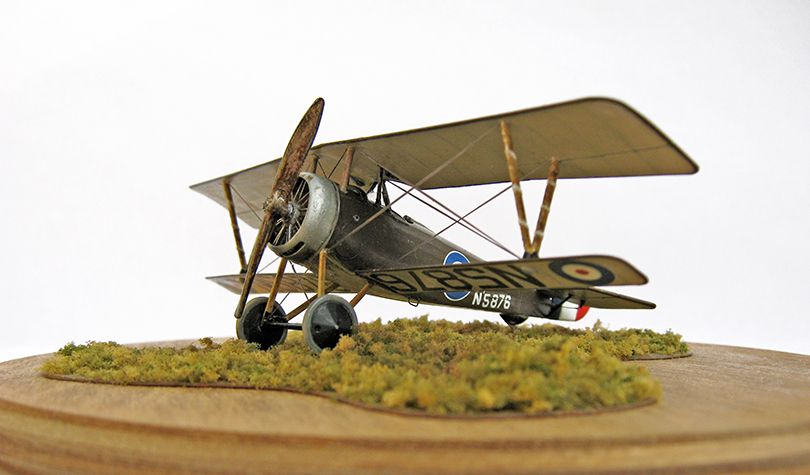
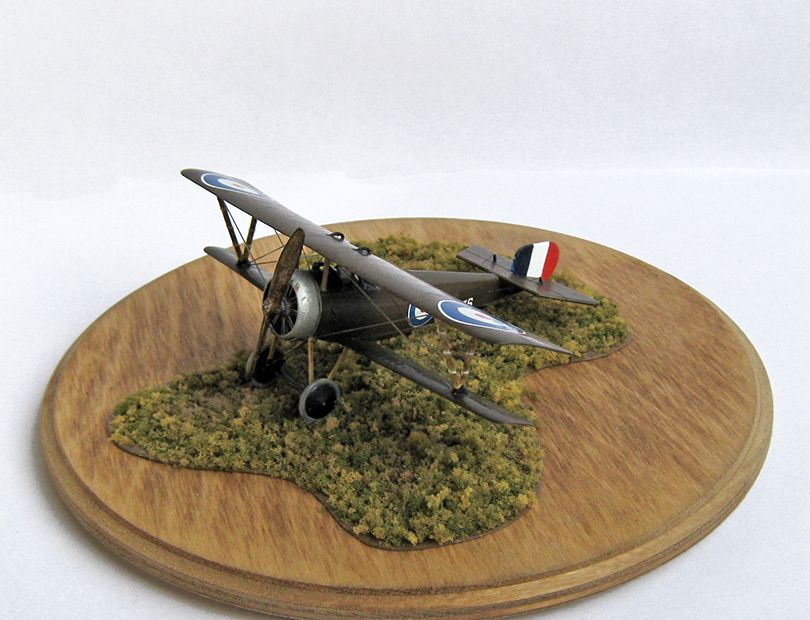
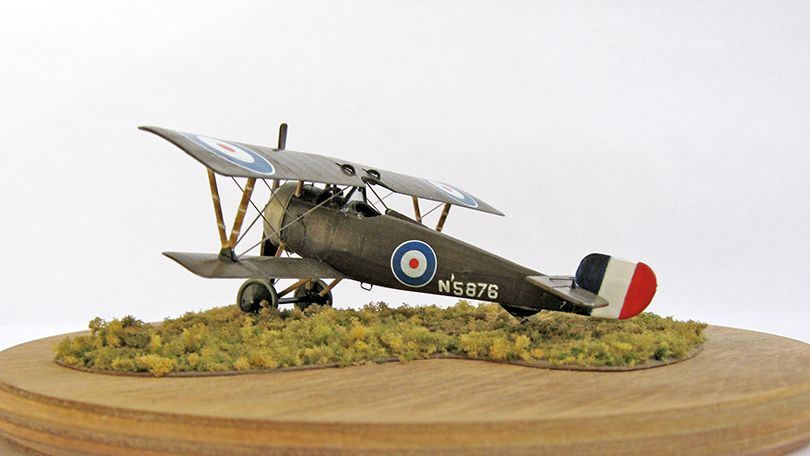
This is a Nieuport N.17bis at No. 11 Training Depot, Old Sarum, in the spring of 1918. It is a blend of an Eduard N.17 kit's wings, and a Roden N.24 fuselage. It is a commonplace among aviation devotees that all later developments can be found pre-figured in the Great War --- this one shows that procurement boondoggles can be pre-figured there along with all the rest:
https://www.britmodeller.com/forums/index.php?/topic/234992831-nieuport-17bis-11-training-depot-old-sarum-spring-1918-in-172/
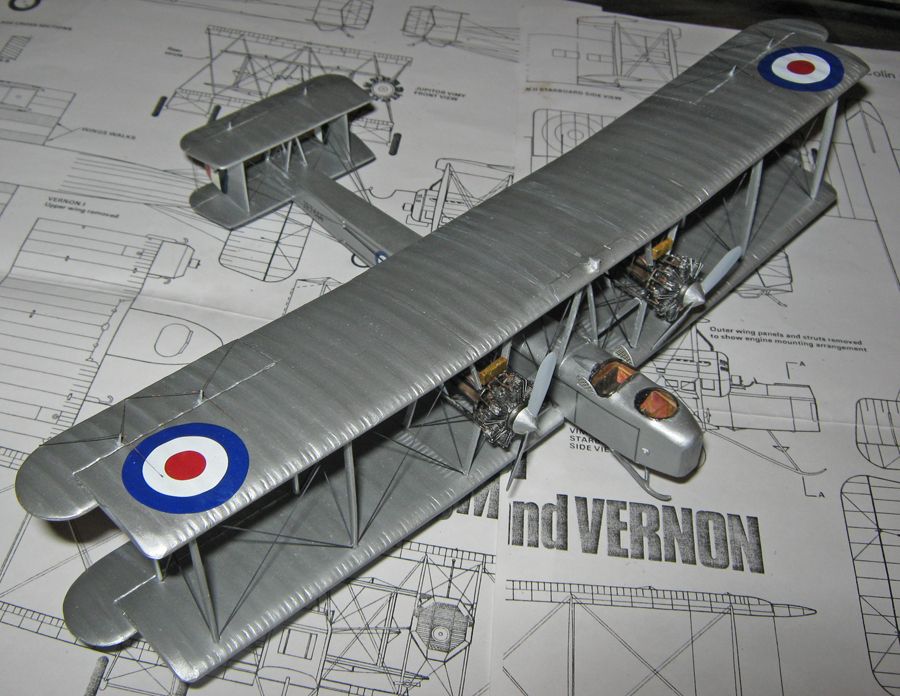
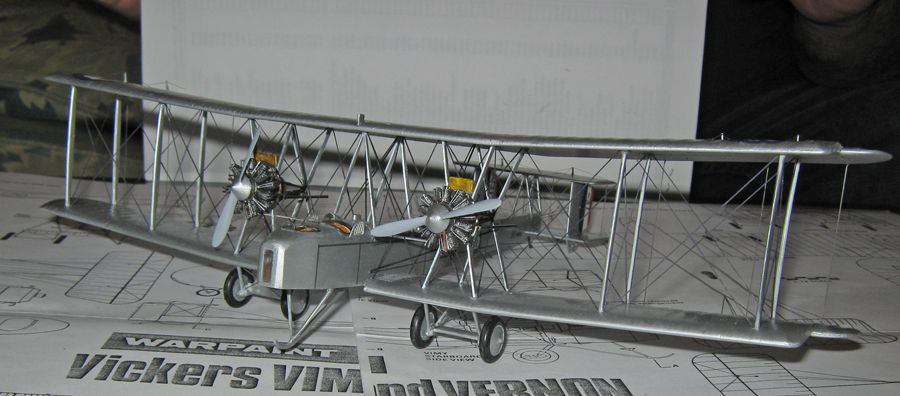
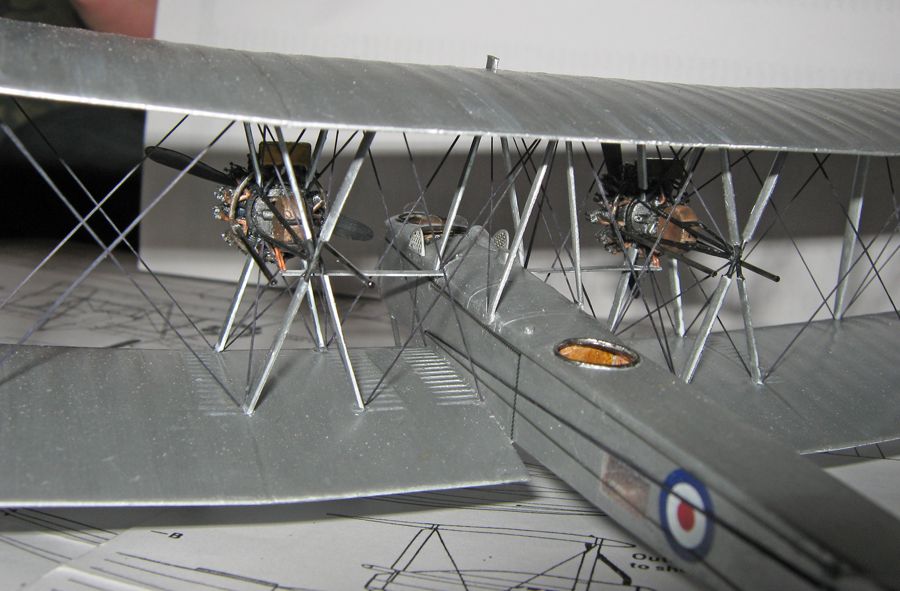
This is Vickers Vimy Trainer refitted with Jaguar radial motors, still in use as a school machine with No. 4 F.T.S. at Abu Sueir during 1930. It is made from an old Frog kit, reissued by Maquette, which needs a great deal of work to make a service Vimy, let alone a school machine, as the kit was intended to represent the extensively modified trans-Atlantic machine of Alcook and Brown (which it does pretty well, actually). The motors are pirated from a pair of Matchbox Sisken kits, and given quite literally a few hundred small plastic tweaks to get them looking all Sir Garnet in their uncowled state.

These are more or less straight kit builds. All are Great War types, though not necessarily Great War subjects.

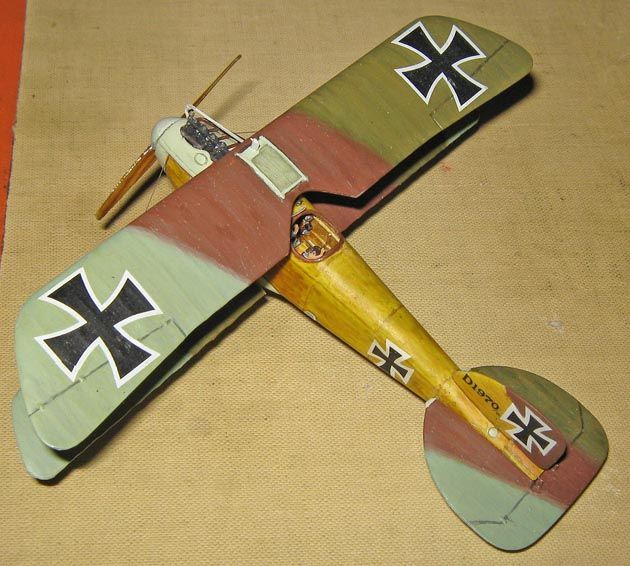
This is an Albatros D.III flown by Lt. Strahle of Jasta 18 in March, 1917. It is a Roden kit, which was a little rough at the rear of the cockpit.

Nieuport 17 of No. 60 Squadron Royal Flying Corps, December, 1916, flown by Lt. Meintjes, built from an Eduard kit. It was involved in an incident which might be comic except that several people were killed in it. Six Nieuports of 60 Sqdn attacked a German observation machine, and managed to wound its officer observer in the foot. He ordered his pilot to land, which the private did. The Nieuports came down to land nearby. There was snow on the ground, and they did not see they were coming down on plowed fields. Four were damaged badly. A number of Canadian soldiers gathered to watch the novel incident. The German pilot had gotten his officer out of his aeroplane. He seems to have forgotten several bombs were aboard, and when he tried to start the machine on fire, these exploded, killing him and several infantrymen.

Albatros D.V of Jasta 4, July, 1917, flown by Sgt. Clausnitzer. He came over low to shoot up an observation balloon, was caught by a flight from 19 Sqdn RFC, who shot up his motor. RFC pilots rescued him from rough handling by artillerymen who got to the intact machine and pilot first. It is built from an Eduard kit.

This a Bristol F2b, operated by No. 2 Squadron RAF in Ireland during the Troubles. It crashed onto rooftops in Barrack St., Waterford Town, in 1920, at the junction of Mr. Aspell's Public House, and the home of a widow, Mrs. McSweeny. It is a Roden kit.
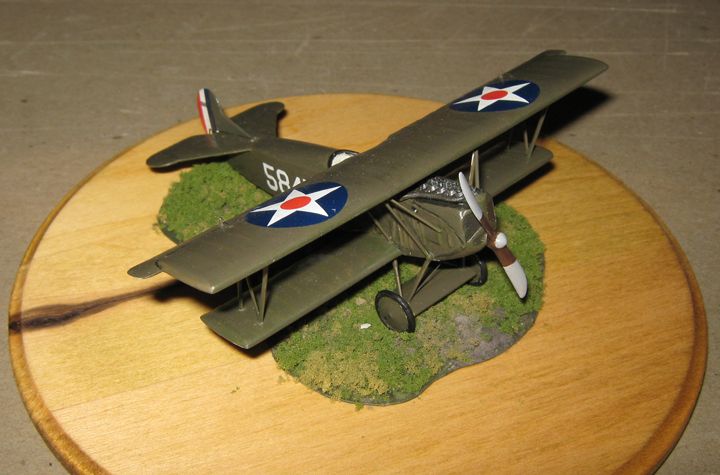
This is a Fokker D.VII operated by the Marines at Brown Field, Quantico, during 1922. It is a Roden kit.
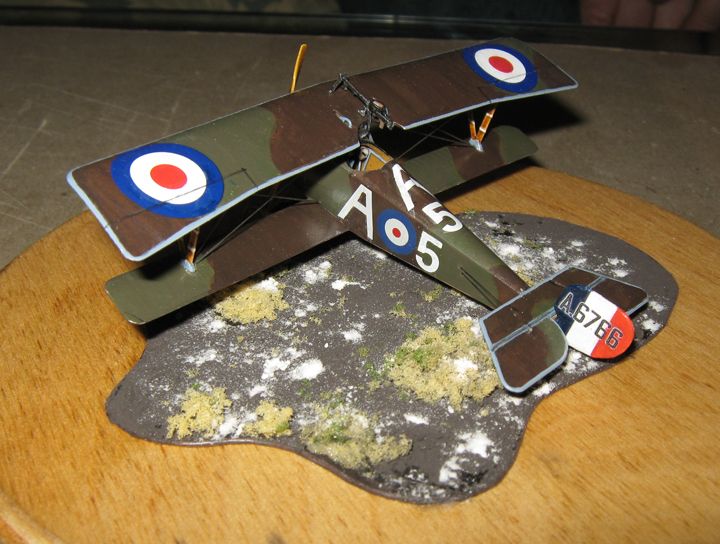
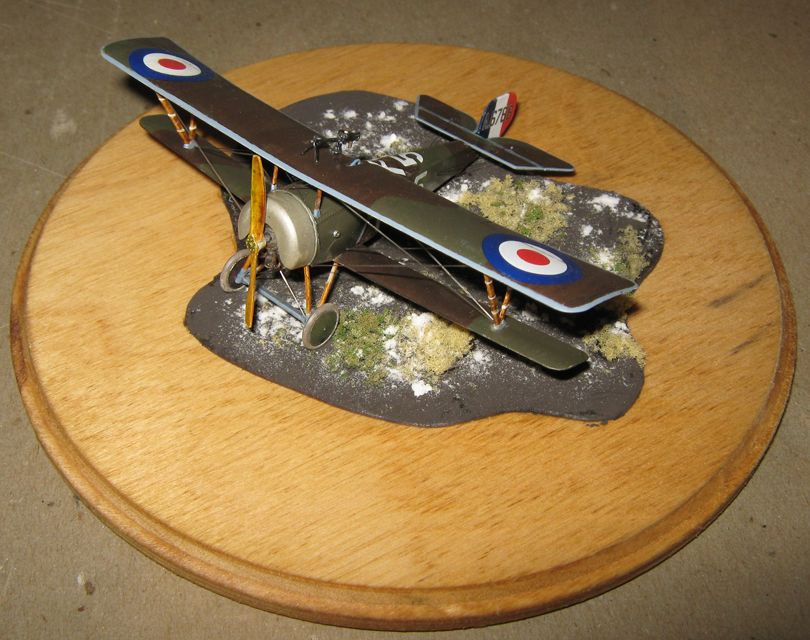
This is Nieuport Scout of 60 Sqdn, RFC, in early April, 1917, built from an Eduard kit. The project turned into a sort of memorial in my mind for its pilot, Lt. C. S. Hall, who was killed at the age of eighteen. For any interested, more can be found here:
https://www.britmodeller.com/forums/index.php?/topic/234938700-nieuport-scout-60-sqdn-april-1917-lt-c-s-hall/
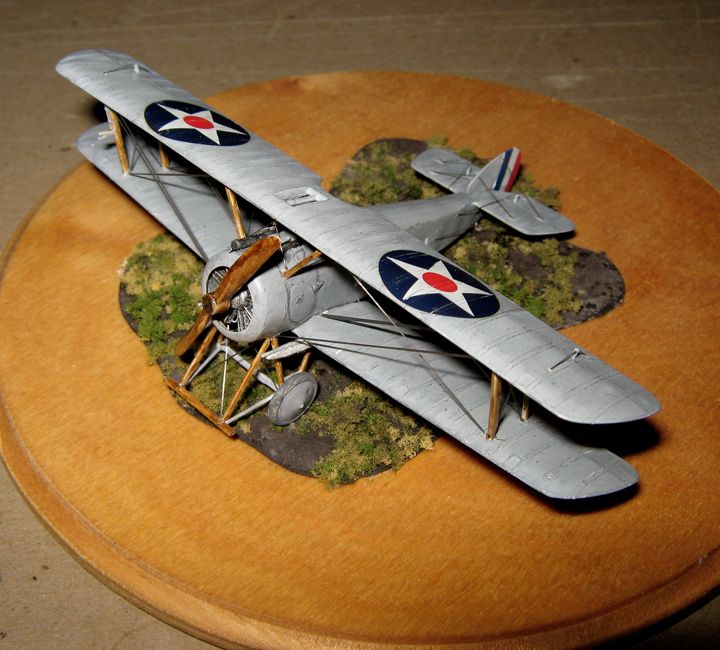
Meant as a Sopwith Camel in U.S.N. service at Guantanamo NAS, 1922, but I botched the center-section cut-outs, leaving them standard, which they were not. This machine was intended to be flown off a platform erected over the guns of a battleship turret, and then to land in the water once its mission was complete. The projections of the undercarriage were a hydrovane to keep the aeroplane from nosing over on contact with the water, and likely drowning the pilot, and it was fitted with floatation bags under the wings. It is from a Roden kit.
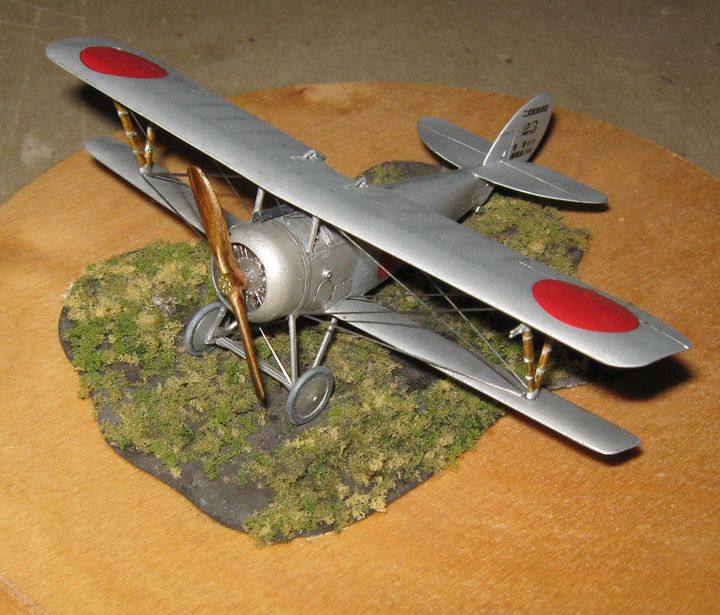
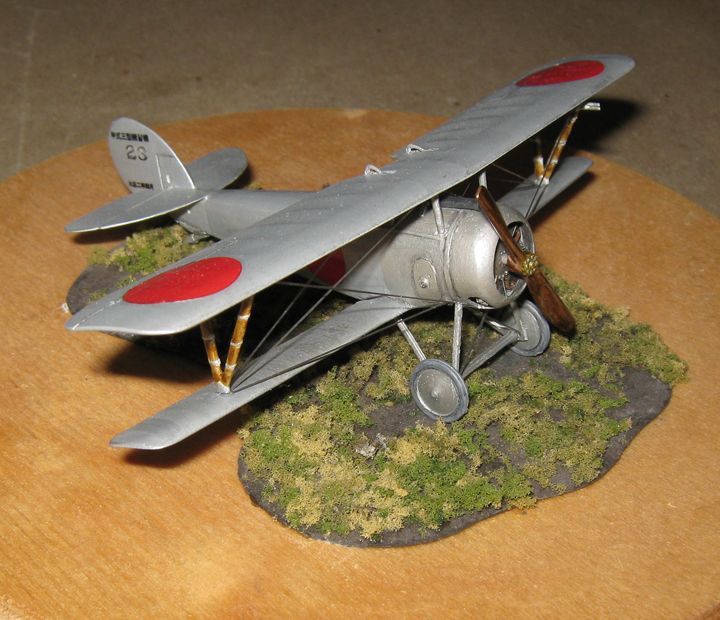
This is a KO-3 training aeroplane of the Imperial Japanese Army Air Force in 1920. It is essentially an N.24 school machine built under license with an 80 hp motor. The same machine, with a 120 hp motor, became front line equipment for the IJAAF during the early twenties. It is built from a Roden kit.
Here is a recent model I forgot in compiling this.

It is a Junkers D.I. from a Roden kit. The type is remarkable for being of all-metal construction. This example was used by a Freikorps unit in Latvia during 1919. The background on this one is well worth a look:
https://www.britmodeller.com/forums/index.php?/topic/235078222-junkers-d1-kampfgeschwader-sachsenberg-latvia-1919/
jpak
(41,757 posts)Fucking amazing
leftieNanner
(15,082 posts)Thank you for sharing these.
![]()
Response to The Magistrate (Original post)
Chin music This message was self-deleted by its author.
The Magistrate
(95,244 posts)I am no pilot, just someone interested in the history of the thing. A fascination growing from some simple books i saw when quite young.
Ocelot II
(115,681 posts)But where do you put them all?
The Magistrate
(95,244 posts)It is a problem, though.
I am very glad you enjoyed them.
MLAA
(17,284 posts)collection. How many years have you been working on them? Whoa!
mac2766
(658 posts)abqtommy
(14,118 posts)design of one of the models which of course was put to good use on the P-38 Lightning built by
Lockheed during WW2.
https://en.wikipedia.org/wiki/Lockheed_P-38_Lightning
The Magistrate
(95,244 posts)

These are A.G.O. (Aerwerke Gustav Otto) C-type designs, employed in 1916 by Bavarian units. The English called them 'two tails' and believed them to be twin-engine, thinking a tractor motor was at the front of each boom, and missing the propulsion engine at the rear of the nacelle. They weren't common, looks were fleeting, the Germans used hardly any pusher types, so it's easy to understand the error. the tail booms were made of plywood verneer, wrapped round a core and glued --- they were quite solid,
The Farman and other 'pusher' (propulsion) designs with a motor in the nacelle rear need some arrangement to provide stabilizing and control surfaces at the rear. Their longerons (the supporting booms) usually converged either in plan or in profile. Drag was tremendous, but in the early days of air fighting, having the biggest weight right about at the center of gravity could make these surprisingly nimble. The Germans called these 'lattice tails'.
abqtommy
(14,118 posts)littlemissmartypants
(22,632 posts)I sincerely hope that they make it intact. Have you thought of donating them to the Air and Space Museum? I would definitely want them preserved. ❤
The Magistrate
(95,244 posts)They're really too small for museum display, though. The camera brings an eye in close in ways a display case couldn't allow.
pdxflyboy
(675 posts)You’re attention to detail, sir, is a work of art. These models are amazing!
Sherman A1
(38,958 posts)Makes me want to break out my Wings of Glory WWI air combat game and take to the (un)friendly skies!
Hiawatha Pete
(1,797 posts)Reminds me of Red Baron (the video game). My favorite aircraft to play were the Sopwith Triplane and Fokker Triplane for the sheer maneuverability.
Your work is museum quality. The detailing, painting and weathering, wow! And in 1/72nd scale... Again, fantastic work, thanks for sharing.
Best Regards,
Pete
dianaredwing
(406 posts)People actually flew these in battle.
Yikes.
Great job.
Congrats.
The Magistrate
(95,244 posts)Glad to hear from you.
I try and weather with a light hand. The 'Elephant' is the only one I got serious about distressing. Well, the Short too. These mostly were produced with a glossy finish, and lots didn't last long enough to lose their shine. The rotary types a special case. These through out their lubricant along with their exhaust, and got serious stains (and dissolved paint) pretty quickly.
eppur_se_muova
(36,260 posts)or, as you (and some others) call it, The Great War, since no one called it WWI at the time. Except for T.E. Lawrence and his exploits, most Americans have no idea of the fighting which took place in the Mideast at that time. Much of what I know of history of that era comes from Peter Hopkirk's series of books on The Great Game.
I used to be a little bit of a model plane buff (but not a very knowledgeable one) as a kid, but I swear I don't remember ever seeing any plane, even a bomber, with a four-wheel undercarriage.
Good luck moving your collection. In all seriousness, you might wish to leave some of your best pieces as gifts to friends rather than risk the packing and moving process, unless you are going to be driving a vehicle carrying little besides the collection itself, as they will be sure to be 'roughed up' in any other case. In any case, lots of luck !
The Magistrate
(95,244 posts)Though it's not strictly accurate, the 'Lawrence of Arabia' movie does capture something of the spirit pretty well.
A book I recommend is 'A Peace to End All Peace' by David Fromkin. It covers events there through the war till 1922. So much of what goes on in that region today comes straight out of those years.
Lithos
(26,403 posts)Great book recommendation for the time period. Thanks for sharing these wonderful models with the world.
Question: You say these were Martinsyde G100 powered by a 120hp Beardmore motor. What difference would there have been had these been G102 w/ the 160hp Beardmore motor?
The Magistrate
(95,244 posts)The answer seems to be not much. The motors could be swapped between existing airframes. The 160 hp version was probably a little faster, but in the face the Albatri tribe over France that didn't make much difference, they could not protect themselves if bounced. Sorties were planned for poor weather. In the Middle East, just about anything that could fly was of some use. Aircraft and flak were sparse enough on both sides any encounter was worth writing home over.
Lithos
(26,403 posts)Engines look to have the exact same dimensions. The best I can tell is that the 160 had higher quality machined parts, particularly around the oil system, and thus could develop a higher pressure and thus horsepower.
You might like this if you've not already book marked this:
https://thevintageaviator.co.nz/projects/engines/beardmore
And thank you for the wonderful rabbit hole you showed me.
The Magistrate
(95,244 posts)Used them in scratching my motor. T hat open-throat feature is a tricky thing. Everything in front of the cockpit is pretty much an eggshell.
Lithos
(26,403 posts)Looking from the front into the cowling shows some fantastic detail work. The cowling itself with the curved metal flow is very subtle to the eye. I have no idea how you did that, other than with skill and patience. My readings tonight mentioned an asymmetrical cowling with an additional access port for the magneto - all of which you captured excellently.
I wish there was some museum which would take these when you are ready for it - they make extremely fine aids to show the design of often unappreciated aircraft from the early days of flight. Gorgeous, absolutely gorgeous. The mind just gets lost into the depths of these things.
eppur_se_muova
(36,260 posts)I saw the movie after reading a few books on the times, which I felt made the movie easier to understand. It was a long movie, but they couldn't get all the background in the way a book does.
And yes, it certainly does echo down to the present day. The whole map of the Middle East was redrawn, almost exclusively to meet the ends of the colonial powers, rather than the peoples who lived there, and had been living there in some cases for centuries. Of course things started to fall apart after that kind of planning.
Quitting before I get banished to the Israel/Palestine forum. :frown:
Jim G.
(14,811 posts)And bookmarked it to go back to read some of the individual accounts.
Thank you for sharing your fascinating work.
The Magistrate
(95,244 posts)With all modesty, i think they are worth looking up.
Rhiannon12866
(205,237 posts)It's also a chronicle of history. Wish I could show these to my Dad. Thank you so much for sharing them with us! ![]()
![]()
![]()
The Magistrate
(95,244 posts)On average, I'd say two or three months for one of these if scratch-built. It sometimes takes longer, but seldom less. And yes, patience is certainly required.
Rhiannon12866
(205,237 posts)Wish my Dad could see them, he would have been very interested, but he didn't have the patience himself. And it also requires a thorough knowledge of history, these deserve to be displayed somewhere special, just hope that they survive their relocation. ![]()
FailureToCommunicate
(14,013 posts)being packed up to send to a museum or such where they may be further curated and appreciated.
Such splendid and loving work!
![]()
![]()
![]()
![]()
![]()
![]()
AllaN01Bear
(18,162 posts)airplane music
The Magistrate
(95,244 posts)The Antoinette monoplane in it is a beautiful thing....

Hekate
(90,645 posts)Perhaps because of your long interests you may already have it, but I stumbled across it at Gutenberg.org a couple of years ago, free for the downloading.
High Adventure: A Narrative of Air Fighting in France
Author: James Norman Hall
“It is strange that we should both have come to France with so little of accurate knowledge of the corps, of the possibilities for enlistment, and of the nature of the requirements for the service. Our knowledge of it, up to the time of sailing, had been confined to a few brief references in the press. It was perhaps necessary that its existence should not be officially recognized in America, or its furtherance encouraged. But it seemed to us at that time, that there must have been actual discouragement on the part of the Government at Washington. However that may be, we wondered if others had followed clues so vague or a call so dimly heard.
This led to a discussion of our individual aptitudes for the service, and we made many comforting discoveries about each other. It is permissible to reveal them now, for the particular encouragement of others who, like ourselves at that time, may be conscious of deficiencies, and who may think that they have none of the qualities essential to the successful aviator.”
“Drew had never been farther from the ground than the top of the Woolworth building. I had once taken a trip in a captive balloon. Drew knew nothing of motors, and had no more knowledge of mechanics than would enable him to wind a watch without breaking the mainspring. My ignorance in this respect was a fair match for his.
We were further handicapped for the French service by our lack of the language. Indeed, this seemed to be the most serious obstacle in the way to success. With a good general knowledge of the language it seemed probable that we might be able to overcome our other deficiencies. Without it, we could see no way to mastering the mechanical knowledge which we supposed must be required as a foundation for the training of a military pilot. In this connection, it may be well to say that we have both been handicapped from the beginning. We have had to learn, through actual experience in the air, and at risk to life and limb, what many of our comrades, both French and American, knew before they had ever climbed into an aeroplane. But it is equally true that scores of excellent pilots with little or no knowledge of the mechanics of the business.”
The Magistrate
(95,244 posts)I know of it, but have not read it, and will do so. I confess to avoiding the Lafayette Escadrille, simply because so much of the material in English on the French air service focuses on it. There is very little on other elements of the French service. For example, that twin-engine Caudron G.VI up there equipped most French reconnaissance units during 1917, and is so obscure by now there are not even any fully accurate drawings, and its history is blended with that of several similar experimental types almost inextricably.
Hall is good writer, I read the Bounty trilogy as a boy with awed fascination.
marked50
(1,366 posts)erronis
(15,241 posts)At times I may have been irritated by your signature responses. Nevermore. You are someone I will always respect - both for these works of war and art, and for your cogent questions and responses.
Salute.
The Magistrate
(95,244 posts)I appreciate your kind comments.
relayerbob
(6,544 posts)I used to enjoy building WW1 aircraft models, in fact, I had a few of yours, but clearly, nowhere near as good!
Percy
(721 posts)Such a stunning collection.
denbot
(9,899 posts)I flashed back to one of the few airplane models I completed, a Sopwith Camel, the “Snoopy plane” as I recall.
Mine never looked that good.
Schmice3
(294 posts)SeattleVet
(5,477 posts)True craftsmanship.
(If I ever attempted anything like that I'd probably wind up with glue blobs, paint runs, mismatched seams, crooked and bubbled decals, and birdsnests in the rigging.)
Submariner
(12,503 posts)Those so accurately detailed models would be worthy as a permanent display at the Smithsonian, if not in your care and hands. Outstanding, thanks for sharing.
WA-03 Democrat
(3,046 posts)I hope they make it safely during the move.
Greatly enjoyed the history and the craftsmanship!
malaise
(268,949 posts)Out of this world fabulous ![]()
The Magistrate
(95,244 posts)Thank you.
OldBaldy1701E
(5,126 posts)(Sorry, had to do it. They are beautiful.)
The Magistrate
(95,244 posts)On the modeling sites, I have noticed a fair proportion of the fellows are former ground crew in various air forces.
dchill
(38,472 posts)This is my favorite period in aviation, and I've put more than a few kits together myself, fairly crudely. Yours are so realistic it's astounding! Kudos to you, sir!
panader0
(25,816 posts)bluecollar2
(3,622 posts)Some years ago I set out to build a model of every RAF fighter that fought in the Battle of Britain.
Sadly, I haven't been able to finish the project. One day....
Great job!!!
The Magistrate
(95,244 posts)Here is mine:
 ?width=1920&height=1080&fit=bounds
?width=1920&height=1080&fit=bounds
It is a machine of 609 Squadron, circa September, 1940, flown mostly by a pilot with the unlikely name of Noël le Chevalier Agazarian.
You might find the background worth reading: he touched on quite a few interesting patches, including one of the great betrayals of the French Resistance.
https://www.britmodeller.com/forums/index.php?/topic/235077256-spitfire-mkia-609-squadron-september-1940/
bluecollar2
(3,622 posts)The goal was to build a fighter representing every squadron. Yours is stunning.
Bo Zarts
(25,394 posts)I’m book marking to use in my research. The history aside, the amount of work that goes into that kind of modeling commands my utmost respect. Museum quality work, it appears to me. Kudos, Sir.
I have written a short essay, that I might post on DU in a day or three, on Ford Madox Ford. I touch on his time in the trenches (at age 41) during WW1. After the Great War, Hemingway worked for Ford, and Hemingway had participated in WW1 as an ambulance driver for the Red Cross. Hemingway, who was selling “pogey bait” to soldiers at a Red Cross mobile canteen was wounded in a mortar attack by Austrian forces.
Anyway, Hemingway hated Ford Madox Ford, mainly because Ford could tell better war stories. Better in both quality and quantity. Hemingway became more and more petulant .. and crapulent.
But I digress. Thank you again for your post, for the wonderful photos. It is an amazing collection!
The Magistrate
(95,244 posts)I read 'The Good Soldier' a long while back, and remember it as a very well done piece of work.
Hotler
(11,420 posts)I had a friend that was hooked bad on the die-cast miniature civil war figures, they were about a 1 1/4 tall. He would detail all the way to painting the buttons on the uniforms. He had cavalry, artillery, and companies of infantry. I think he had enough to set up Gettysburg in the basement.
Again, nice job on the planes.
The Magistrate
(95,244 posts)Those people leave me flabbergasted.
WheelWalker
(8,955 posts)Thousands... Moments of Zen
The Magistrate
(95,244 posts)"This would be a lot easier if I could see what I was doing!"
The Magistrate
(95,244 posts)I regret that my energies are flagging with the lateness of the hour, and are at a point where I must make a general acknowledgement.
It's been a real shot in the arm.
Thank you all.
lunatica
(53,410 posts)You show much discipline and dedication! Very impressive!
MerryHolidays
(7,715 posts)The amount of detail in your OP is stunning, as are your planes. Beautiful in all respects.
One question: when you say you build these "from scratch", do you mean completely from scratch? You're not using a kit in other words?
Ok, I lied, a second question: these are really fabulous. Is your focus WWI planes? Have you made models related to other eras?
Please take care of your models!
And thank you. It has been a privilege for us to share in this with you.
The Magistrate
(95,244 posts)Here's what the 'kit' for the Short 827 looked like:
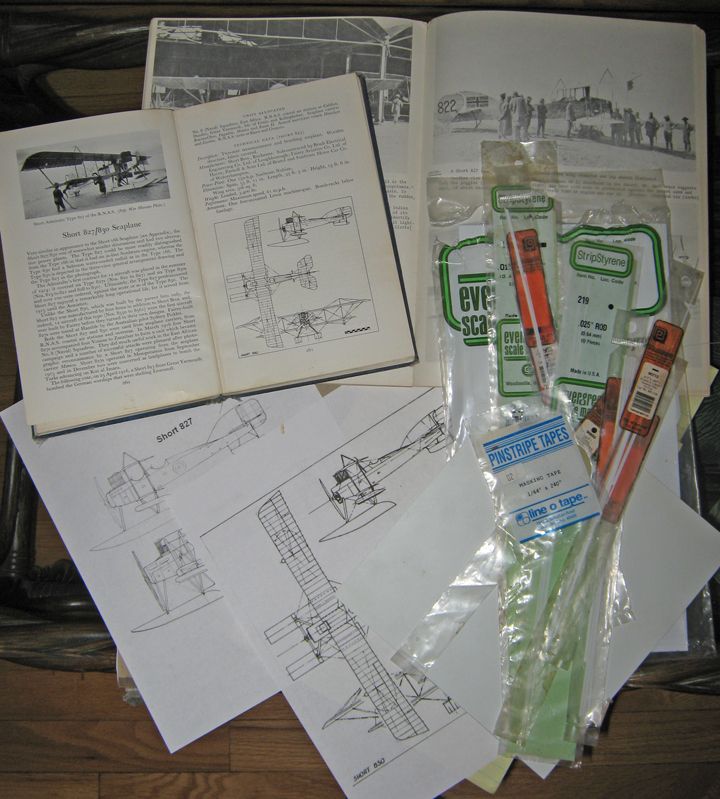
I will on occasion pirate bits from the spares box, armament or propellers or wheels, sometimes an engine, that sort of thing.
Here's a link to the construction of the Short 827, for some idea of the process.
https://www.britmodeller.com/forums/index.php?/topic/234961961-short-827-converted-rnas-mesopoptamia-1915-scratch-build-in-172/
I have always been most interested in the earlier period, but I do many types from the twenties and thirties, and some from the Second World War. This is the last one I have finished, a Curtiss 'Mohawk IV' in Burma:

malthaussen
(17,187 posts)flotsam
(3,268 posts)And above the rest I appreciate the respect and dignity you extend to all other posters. Like you I caught an early bug and became a fan of "Great War" aviation....funny to think we are now farther removed from Mustangs and Messerschmitts then we were from Spads and Fokkers then...Your modeling skills amaze and moreso the earlier and lesser known models-I completely missed the middle eastern and African campaigns of that war. And since we all get a vote mine for most elegant is the Albatross D5 even though I love the pusher designs. I do have a question-your Breuget U1 and several other examples show stacked boxes forward-are those actually ammunition cans or some type of engine device?
I think my best thanks might be to give you a slightly later slice of aviation history involving Igor Sikorsky. I'm betting you already know him pretty well but for fans of history he flew his first helicopter in my hometown and was actually an occasional guest at the childhood home of my ex-wife. And where I live now (Rochester NH) an aviation buff spent 40 years restoring a single engine seaplane originally owned by a married set of adventure cinematographers who explored Africa and primitive cultures in the islands of the Pacific. Anyhow I'll add a few links-when you settle into your new home I hope you might enjoy them.
https://www.fantasyofflight.com/collection/aircraft/currently-not-showing-in-museum/golden-age/1930-sikorsky-s-39/
https://en.wikipedia.org/wiki/Martin_and_Osa_Johnson
The Magistrate
(95,244 posts)That is an interesting item. Since it is civil, I don't suppose the finish was meant as camouflage --- was it meant to resemble a leopard's skin?
What you see on the Breguet and the Short and the 'Steel Farman' are radiators. We are accustomed to radial motors being air-cooled, but the Canton-Unne radial was water-cooled, with each cylinder enclosed in a copper jacket. The Short's radiator for its Sunbeam 'straight six' was an odd contrivance, placed in an exceedingly odd place. It consisted of a great many thin plates, edge-on to the airflow, through which the water circulated.
I agree the Albatross is pleasing to the eye, and on sheer artistic grounds, I am particularly fond of the blonde-wood with mauve and olive green finish. The use of mauve in the camouflage scheme has an odd background. Both French and Germans used a camouflage of greens and red-brown during 1916, and early in 1917 the Germans thought to reduce risk of mistakes by removing the brown from their machines. The patterns of different colors were intended not just to blend with a background, but to 'break up' the shape of the machine under a quick glance. Human color vision is focused on green, and has very little room for purples. Thus alternating patches of green and purple perform this 'breaking up' better than just about any other combination --- the quick glance sees the green without quite noting the purple, in effect, so the whole shape does not immediately cohere. That said, it is worth noting that camouflage in the air doesn't work nearly so well as theories suggest it ought to. What catches the eye is the object's movement, and the difference in reflectivity between it and the background.
flotsam
(3,268 posts)The Johnsons had 2 seaplanes with the second being type S38 which was a near identical twin engine version. That aircraft was painted with zebra stripes. I think it was to limit the panic of animals they hoped to film. Note they didn't use predator patterns. Anyhow thanks for the info. Also here is a link to a photo of the S38.
https://obscureco.wordpress.com/tag/osa-and-martin-johnson-safari-adventure-museum/